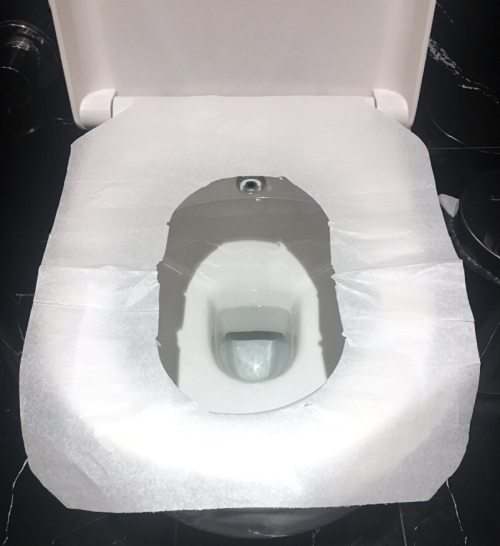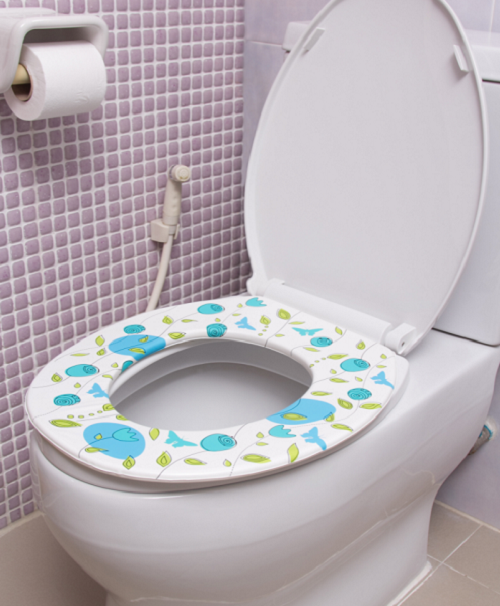Toilet seat covers often add extra protection in not-so-clean public bathrooms. But some are designed to be decorative, not functional. One question people have after using them is, “Are toilet seat covers flushable?”
A simple answer to note is most toilet seat covers are flushable, including those commonly available in public toilets. However, some are meant for decoration and, as such, are not flushable. Doing so will require the services of a plumber to unclog the sewer system and drains.
Below we explore the world of toilet seat covers and see if and when you can flush them.
What Are Toilet Seat Covers Made Of?
Toilet seat covers are made of different materials, including paper, plastic, and vinyl, although some environmentally friendly brands use recycled materials.
There are also non-disposable toilet seat covers made of plastic, faux fur, wood, or even porcelain. These are washable, hence able to maintain sanitation. They are also reusable, which might be good for the environment to a certain degree.
Aside from material, toilet seat covers also come in different shapes and sizes. Like toilet seats, some covers are circular, rectangular, or elongated.
Are Disposable Toilet Seat Covers Flushable
The paper toilet seat covers you mostly find in public toilets contain flexible material that starts to break down when it hits the water. This means you can flush them without the worry of clogging the toilet. Be sure to flush after a single use to maintain sanitation. And don’t flush a bunch of them at once, as that can form a clog.
On the other hand, plastic and vinyl toilet seat covers are disposable but not flushable.
Note that several other factors will determine how well to dispose of your toilet seat covers. For instance, it may not be wise to flush if you have weak plumbing. This is more applicable in older buildings where sewer piping and drains are not as clear and free-flowing. Flushing something as large as a toilet seat cover could lead to clogging.
You also want to avoid flushing toilet seat covers in buildings with a rural septic system. Septic systems spread waste throughout a septic field, unlike town/city sewer lines with industrial facilities to help break things down.
In the event that you can’t flush down a toilet seat cover, you can always dispose it of in the garbage.
Can You Flush Decorative Toilet Seat Covers?
Decorative toilet seat covers are meant to spruce up an otherwise unsightly or plain toilet seat. They tend to feature cotton or faux fur styles, and these materials don’t break down easily. This means they are not to be flushed; rather, they can be disposed of in the garbage.
What Is The Purpose Of The Toilet Seat Cover?
Toilets, especially those in public places, carry germs, viruses, bacteria, and invisible diseases. The good news is you can reduce contact with these germs and diseases in several ways so they don’t seriously impact your health. One of the lines of defense is using toilet seat covers.
The main purpose of a toilet seat cover is to provide a physical barrier between the toilet and users. You no longer have to sit in direct contact with germs on toilet seats.
A toilet seat cover also provides users with a more comfortable experience. When people don’t feel comfortable sitting on a public toilet, they’ll start hovering over it. And in the process, they’re more likely to cause a bigger and germier mess for other users.
Are Toilet Seat Covers Necessary
There’s a certain comfort in using a toilet seat cover in a public toilet, but does it really protect you from germs?
While these covers act as a physical barrier between you and the dirty toilet seat, that thin layer of paper isn’t really stopping the transmission of anything. Like toilet paper, toilet seat covers are quite porous, containing large holes that allow microorganisms to slip through. You may get a little protection using multiple layers of covers, but this isn’t recommended as it can clog the toilet.
People started using toilet seat covers because they believed toilet seats were a way of transmitting STIs and gastrointestinal infections. But that’s certainly not the case. Did you know that toilet surfaces are made smooth to prevent bacteria from being able to latch on? Secondly, toilet seats don’t stay warm long enough to allow bacteria to stay alive.
Of course, germs are lurking all over the bathroom. But most bacteria are common skin microbes that most people already have. While your bum may be touching the toilet seat, your skin is a barrier to keeping germs away. The only way for germs and diseases to get inside your body is if you have an open sore or cut. In that case, we recommend visiting a doctor to help treat your open wounds.
While we’re on the topic of disease-causing bacteria, it’s important to know that regular items foster as much, if not more, germs than toilet seats. This includes money, TV remotes, refrigerator, shoe laces, keys, doorknobs, light switches, keyboards, etc. In fact, according to research, the average cell phone has up to ten times more germs than the average toilet seat. At least most toilet seats are cleaned regularly.
Are Paper Toilet Seat Covers Effective?

As we’ve seen, toilet seat covers are not effective at preventing the spread of germs and diseases in the toilet.
Another fact is that germs are more likely to be spread from the flushing of the toilet. When bits of fecal matter blast into the air, they settle on surfaces, including spreading to your hands, eyes, nose, and mouth. The best way to prevent germ transmission while using the toilet is to wash your hands afterward. Be sure to use plenty of water and soap to wash your hands. Also, scrub for no less than 20 seconds and rinse thoroughly.
That said, if toilet seat covers make you feel safer when you would otherwise hover instead of sitting, use them.
Are Toilet Seat Covers Sanitary
As mentioned earlier, paper toilet seat covers are absorbent and allow bacteria and viruses to pass through. This makes them just as sanitary as the toilet seat.
The plastic and other reusable toilet seat covers are not porous, thus providing a better barrier between the skin and the toilet. But on the other hand, they increase the surfaces for germs to multiply.
All you need to do to keep the toilet seats clean and sanitary is regularly clean them. If you’re using bathrooms outside of your home, take comfort in knowing that germ transmission is unlikely, even without a cover.
Are Toilet Seat Covers Bad For The Environment?
When deciding whether or not to use toilet seat covers, keep in mind their effect on the environment. For starters, the added paper used to manufacture these items has an environmental cost. Don’t forget the additional water required to flush and break down the paper covers. You can reduce these effects by limiting how often you use toilet seat covers.
While most toilet seat covers are made of paper, some are made of plastic. And we all know how bad plastic is for the environment. When disposed of, plastic doesn’t decompose fast. Also, the chemicals found in plastic will seep into the ground, thus contaminating the surrounding soil and water.
How To Use Toilet Seat Covers Properly
We’ve all been in that awkward moment in unfamiliar bathrooms where you’re unsure what’s functional and what’s decorative. Toilet seat covers are not common everywhere, so you may wonder how well to use them. In this section, we discuss how to place a toilet seat cover and how to dispose of it.
In most public toilets, you’ll find a dispenser with toilet seat covers located above the toilet. Go ahead and pull out one cover and unfold it. Ensure the toilet seat is dry by wiping it out with toilet paper. This keeps the cover from absorbing any moisture or fecal matter.
The next step is to place the cover onto the toilet seat, ensuring every part is covered so your skin won’t be touching the toilet seat.
Most toilet seat covers have a flap, which is the middle circular section. You want to align the flap so it falls inside the toilet bowl with the part still connected to the cover sitting in the front. Having the flap in the front and not in the back will help prevent unsightly and uncomfortable splatter.
Once you’re done using the toilet, flush it. The flap at the front will pull the entire cover into the bowl, so you don’t have to touch a used cover. And even if you use your hands, you’ll still wash them before leaving the facilities.
Final Thoughts on “Are Toilet Seat Covers Flushable”?
Disposable toilet seat covers come in handy for use in public toilets. And while they may not protect you from disease-causing bacteria and viruses, they still manage to keep the toilet clean and your mind at ease.
When confronted with the question, “Are toilet seat covers flushable,” there’s no straightforward answer. It depends on the material, as paper covers are flushable while plastic covers are not. The good news is that most toilet seat covers have instructions stating whether they can be flushed, so you’re not confused.
That being said, thoroughly washing your hands after using the bathroom is always the best way to counter germs.


